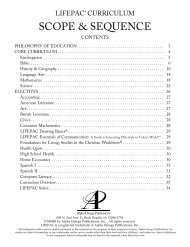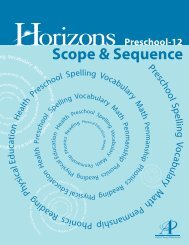Horizons Math Sampler - Odyssey Academy
Horizons Math Sampler - Odyssey Academy
Horizons Math Sampler - Odyssey Academy
Create successful ePaper yourself
Turn your PDF publications into a flip-book with our unique Google optimized e-Paper software.
All concepts are covered in a flexible yet methodical way in this curriculum. The Concept<br />
Development Chart illustrates the usual pattern of concept progression through the lesson sequence.<br />
In any given lesson you will likely find concepts at various stages of their unfolding for the student.<br />
Some concepts will be introduced. These are always the first item on the page. Other concepts will be<br />
either in one of the practice phases, the break phase (in which case they do not appear in a lesson) or<br />
at one of the review or reinforcement phases. While Lesson 34 consists of two concepts in the<br />
secondary practice phase, three concepts in the primary practice phase, and two concepts in the<br />
introductory phase, Lesson 50 consists of one concept in the break phase, four concepts in the<br />
secondary practice phase, three concepts in the primary practice phase, and one concept in the<br />
introductory phase. This repetition insures a thorough coverage over the entire year and is designed<br />
to promote comprehensive learning. The Concept Development Chart shows the general pattern<br />
followed in creating the lessons. The actual pattern found in the lessons will vary because<br />
consideration was given to the relative importance of each concept.<br />
Extrapolation: Each lesson presents practice of several different concepts for the students. This<br />
mirrors the real life experiences of the average individual. Today’s opportunities require yesterday’s<br />
experience in working through them. With three or more different concepts being covered in each<br />
Horizon’s lesson the student must be capable of multitasking and applying previously learned<br />
techniques. Connections are more easily seen between different concepts because they are not<br />
covered in isolation.<br />
Teacher Role: Horizon’s contains a total of 160 lessons and 16 tests (Grades 1-6). Typically, one<br />
lesson should be completed each day during the school year. Prepare for each day by carefully<br />
reviewing the material provided in the Teacher’s Guide. The Overview is a summary of the concepts<br />
that will be covered in the lesson. Also review the Scope and Sequence, found in the front of each<br />
Teacher’s Guide to see what concepts will be taught in future lessons. The Materials and Supplies is<br />
a list of what will be needed for the lesson. Get these items assembled before starting class with the<br />
students. Since many will be used for several lessons you may choose to hang them on the wall or on<br />
a bulletin board. The Teaching Tips are classroom-teaching procedures that give special instructions<br />
for each activity of the lesson. Take your time in going over these procedures. Thoroughly think<br />
through what you will say and do, so that you have a plan in your mind before teaching the lesson to<br />
the students. The Answer Keys for K-3 are reduced student pages with answers. These pages allow<br />
you to have both the Teacher Notes and the Student pages in front of as you teach the lesson.<br />
16








